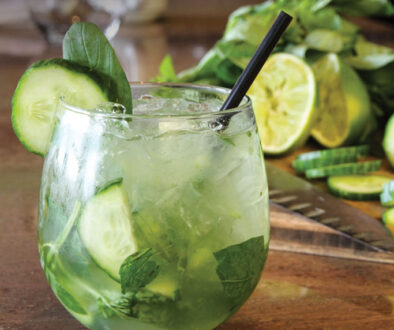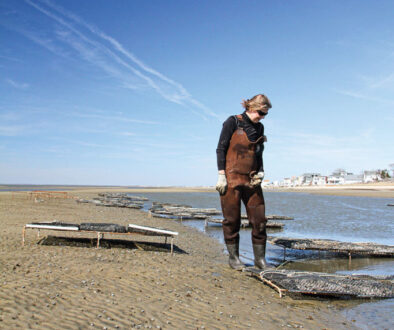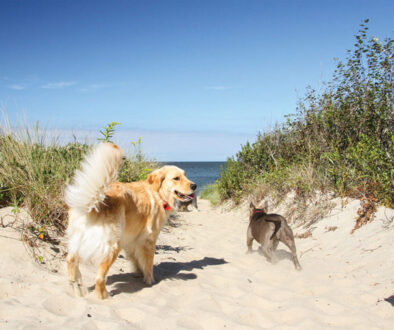Lightning in a Bottle
The first thing I noticed upon entering Nauti Spirits Distillery in Cold Spring was the smell: a tart, almost yeasty aroma, vaguely reminiscent of a holiday kitchen.
“That’s the sweet potatoes,” said my tour guide, JB (“like the Scotch”) Wheatley, of the wooden crates piled high with multi-colored spuds. “Makes it smell like Thanksgiving.”
Almost as an afterthought, she added, “You’re also smelling the alcohol.”
Ah yes, the alcohol. Here at Nauti Spirits, those humble root vegetables are transformed into high-octane vodka: all small-batch, all made from locally harvested produce.

Kindred Spirits
Based inside three massive, red-roofed barns, Nauti Spirits includes a retail area, a tasting area and a distilling operation. The latter is dominated by two custom-made stills from the venerable Vendome Copper and Brass Works of Louisville (yep, your favorite Kentucky bourbon originated in a still like this). Each one looms 25 feet high, weighs about 8,000 pounds, and has more gauges, levers, twisting pipes and portholes than a Rube Goldberg machine.
In a nod to local rum-running history, the tasting room has the rough-and-ready look of an old fish-packing warehouse, with concrete floors, a soaring, galvanized-steel ceiling, cast-iron stove and a rough-hewn 24-foot bar, made of beams from decommissioned sailing ships. The shop up front sells barware, souvenirs, and of course, those delectable, home-grown spirits. By law, visitors may buy up to six bottles of spirits per person, per day.
Though it all looks very complex, the basics of booze-making have been practiced by everyone from the seafarers of old to the moonshiners of Appalachia to the bootleggers of the 1920s and 30s.
“All alcohol requires is a sugar source,” explained JB. “You can use grain, corn, or even sugar for that matter” (the latter for a yummy-sounding brew known as “sugar shine”).
After four years of planning and preparation, Nauti Spirits will be open to the public by the time you read this. It’s the brainchild of three partners: Steve Miller, a locally based energy lawyer, and the husband-and-wife team of Corey and Dorey Bryan. He owned the Lemon Tree restaurant, a longtime mainstay of the Washington Street Mall, and she is an administrative assistant at West Cape May Elementary School. All of which raises the question: Why a distillery?
“We just got the bug,” said Miller. “Distilling is a lot like brewing, but there’s more to it than that. It’s a mixture of art and science that just grabbed me.” Besides, he adds, “There wasn’t any distillery around here that does it from scratch.”
He means that literally. The raw sweet potatoes, some grown on the 60-acre farm where Nauti Spirits is based, are first washed in a bin. They then travel up a chute, where they’re dumped into a 1,500-gallon mashing vessel. After cooking, the mash is funneled into giant aluminum tanks for fermenting, and finally deposited in huge copper stills for distilling and filtering.

First Fruits
At the start, Steve and Corey planned to do it all themselves, and even enrolled in Michigan State University’s Artisan Distilling program to learn the business. “But we quickly understood that was a dumb idea if we wanted to do it right,” said Miller. “We had to find somebody who really knew what they were doing—and that’s that guy over there.”
He gestured to Brendan Wheatley, JB’s husband, an executive distiller who’s mastered his craft at companies around the world. He started out brewing beer, went on to study whiskey production in Tokyo, then joined Germain-Robin in Southern California, learning classic French techniques for the production and cellaring of brandy.
“I’m part of the first generation of career micro-distillers,” said Brendan. “I’ve done rum, many types of vodkas, gins, brandy and liqueurs—everything but tequila.” Most recently he was head distiller at St. Augustine Distillery in Florida; he and his wife run a distillery consulting firm called Plethora Brands.
For Nauti Spirit’s inaugural year, two acres of the farm on Shunpike Road were set aside for sweet potatoes. It’s an unusual base ingredient, said Brendan, who was careful to point out that the distillery produces vodka made with sweet potatoes, and not sweet potato-flavored vodka.
“There are some other sweet potato producers throughout the United States, but very few,” he said. “You can get the essence of it and you can definitely get the sweet, aromatic, flowery notes, but vodka is always the bridesmaid, never the bride. When you mix it, it should disappear.”
At long last, I was offered a sample from the latest batch, two or three fingers-full in a tiny glass. The liquid was sparkling and crystal-clear with a tangy aroma. With each sip, its crisp, fresh taste seemed to modulate ever so slightly, in a rush of unfolding impressions, subtle but good. Stumped for a way to describe it, I simply said to Brendan, “It keeps tasting different.”
“As it should,” he replied. “You should have a dialogue with your spirits.”
I asked if it takes a special talent or taste to appreciate distilled beverages. “Out of every 10 people, one has a foot for a nose, one has the potential to be a super-taster,” he said. “And everyone else is in between on the continuum. While everyone can probably be trained to work in a distillery, it takes decades of practice to become an international blender, flying around the world to do this. The more you do this, in the same way that you develop muscle memory by playing music, your pitch gets better and your overall understanding gets better. More importantly, contextually you get better at this—how your spirits stack up relative to 10 others available on the market.”
What is his definition of a craft-distilled beverage?
“A number of people are claiming that definition, but for us it means you start with raw ingredients—in this case, sweet potatoes—and move it to finished spirit, farm to bottle,” said Brendan. “Not many people do that.”
To my surprise, he said, “Feel free to spit”—i.e., expectorate this lovely vodka into a drain in the floor of the still room.
Not a chance.
Let’s Get Small
Micro-distilling is a fairly recent phenomenon. Will it explode like the micro-brewing craze that preceded it? Could be. In a 2015 report, Credit Suisse analysts noted that the market now controlled by large-scale national brands “is becoming increasingly focused on local, authentic, small-batch production.”
It’s still a David-and-Goliath situation, however; according to Reuters, craft distillers (those producing fewer than 100,000 cases a year) now account for just two percent of manufacturing in the U.S. By contrast, independent brewers command 13 percent of the market for beer. Moreover, New Jersey lawmakers keep a firm lid on producers, who may not sell more than 20,000 gallons annually (whereas in New York, production is capped at 70,000 gallons, and in Pennsylvania distillers can produce all they like without limit).
For Wheatley, it’s almost a non-issue. “The big boys produce millions of gallons,” he said. But mass-produced spirits, however fine, are essentially different from artisan distilled beverages. For Nauti Spirits, vodka is just the start.
“Vodka is a big deal and will continue to be some of our bread and butter,” he said, “but we’ll start to see what excels here beyond that. I’m very excited about the orchards in the state, the blueberries, the cranberries…”
“We’re going to do grain-based gins, whiskies, brandies and rum,” agreed Miller. “We’ll be able to make any type of spirit you can think of. “Nauti Spirits will be a place where people—tourists and locals alike—come out time and again, year-round. First, we’ve got to get our retail going and create a buzz around this. No pun intended.”
Cape May Distillery is bringing back Prohibition—sort of. Located on Route 47 in Cape May Court House, the distillery looks like a 1920’s style speakeasy complete with red velvet sofa, fringed lampshades, cage lights with old-style filament bulbs, and even a “secret passage”—a doorway disguised as an old-time phone booth.
The distillery offers hand-crafted spirits “blended, distilled and bottled by hand,” said Director of Operations J. Lee Lineburg. “It’s corked by hand, sealed by hand, labeled, boxed and stored by hand, and then hand-delivered.”
Launched in 2013 by college friends Nathan Dolezel and Lee Phillips, Cape May Distillery started out with two blended rums. Its barrel rum is “a Latin-style sipping rum that you can pour over the rocks with a piece of fruit and drink like you would a whisky or Scotch,” said Lineburg. Its beach rum has beaten Bacardi Silver in some taste tests in Cape May. With its hint of vanilla, it’s a perfect substitute in drinks usually made with vodka.
“The reason is a blending process in which we bring in 190 proof cane sugar and ethanol, then put it through our flavor profile and bring it down to 80 proof through a multi-water process,” said Lineburg. “So you’re getting the purest water and the purest possible rum. And you don’t get what’s called ‘the burn,’ the slam to the back of the throat when you drink. You get a warming sensation as it goes down, but not the bite to the back of your throat like you get with most rums.”
One of the distillery’s signature products was the result of a lucky accident: when an attempt to make a honey liqueur went sideways, the distillers opted for double-barrel honey spirits, created—in the craft-distilling spirit—from 100 percent local honey.
“We were the first in the country, possibly the world, to take honey, ferment it for over four months, distill it and age it in two barrels: a bourbon barrel and a white wine barrel,” said Lineburg.
A limited edition of 600 bottles is now available, not just onsite at the “speak,” but in local restaurants, bars, and liquor stores, as well as the Borgata and Resorts in Atlantic City. The products may soon be available at Whole Foods and Wegmans, and are already stocked by Stew Leonard’s supermarket chain in Connecticut and New York.
Cape May Distillery has recently added blueberry rum and toasted coconut rum to the lineup, and future plans include small-batch bourbons, specialized brandies, and gin. The distillery even offers a Barrel Program where customers can hand-select their own barrel of “Single Barrel Select” to mark weddings, anniversaries, and other special occasions.
Meanwhile, the distillery is open for tastings, tours, and a truly vintage drinking experience.

Guzzler’s Glossary
Call it hooch, booze, John Barleycorn, or “O Be Joyful.” If you appreciate distilled beverages, why not learn the vocabulary? Here are the ABCs of ordering your favorite intoxicant.
ABV: Alcohol by volume. ABV equals one-half of the spirit’s proof. On average, the ABV for beer is 4.5 percent; for wine, 11.6 percent; and for liquor, 37 percent, according to the Alcohol Research Group of the Public Health Institute.
Back: A non-alcoholic drink, like water or soda to sip it alongside a drink ordered “neat.”
Bruised: A drink, usually a martini, that’s been shaken (not stirred) with ice, a la 007. Shaking creates aeration or fizz, which some sensitive souls have dubbed “bruising.”
Bouquet: Quite simply, it’s the smell of a wine or spirit. Drop this term liberally to sound like an expert.
Chaser: Any drink you chug to kick back a shot of hard whisky. For example, a boilermaker is a shot of whiskey with a beer chaser.
Cocktail: A cocktail by definition must contain sugar, alcohol and bitters. An old-fashioned is a cocktail; a gin and tonic is a mixed drink.
Dirty: A drink spiked with olive brine. The olive taste overpowers or “muddies” the alcohol, hence the term “dirty.” FDR is said to have served dirty martinis to Stalin and Churchill, thereby speeding the end of the Second World War.
Finger: A measurement of alcohol, usually about an ounce, indicated by the width of a finger. The term supposedly originated in the Old West.
Highball: Any spirit served with ice and a mixer in a tall glass.
Neat: Liquor served straight from the bottle, sans ice.
Nose: The aroma or the bouquet of a wine.
Shooter: A strong mixed drink that contains two or more spirits. Shooters are meant to be chugged, or kicked back fast.
Straight Up: A drink that’s shaken or stirred with ice, then strained into a stemmed glass.
White Lightning: Another name for moonshine, the kind of high-proof hooch historically cooked up in the Appalachian backwoods, out of sight of the “revenuers.” Also known as mountain dew, corn liquor, white dog and of course, moonshine, because it was typically distilled at night, under the silvery moon.



